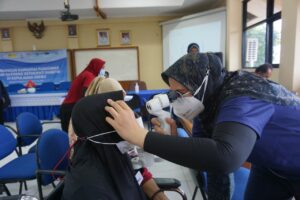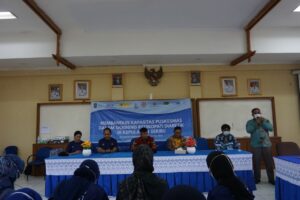Preventing Diabetic Retinopathy in Diabetic Patients, FKUI Educated Health Workers and Communities on Kepulauan Seribu
Diabetes Mellitus (DM) is a chronic metabolic disease characterized by high blood sugar levels accompanied by disturbances in carbohydrate, lipid and protein metabolism as a result of insulin function insufficiency. DM is a global and national problem because the number is increasing sharply from year to year. Basic Health Research (Rikesdas) of the Ministry of Health of the Republic of Indonesia estimates that by 2030, the total DM population in Indonesia will reach 21.3 million people and make Indonesia the fourth ranked country with the largest DM population in the world. Although Kepulauan Seribu is close to Jakarta, it has geographical conditions (consisting of a group of islands) that have the potential to cause limitations in the health sector, including the availability of medical personnel who are trained in providing health services to DM patients and their complications.
According to data from Suku Dinas Kesehatan (Sudinkes), currently Kepulauan Seribu is in the third rank with the highest DM prevalence in DKI Jakarta, which is 2.7%. About 35% of DM patients are at risk of developing Diabetic Retinopathy, which can cause blindness.

Community service activities in the form of webinars and workshops for health workers at the Public Health Centers in Kepulauan Seribu area and other DKI Jakarta areas took place online on October 18-19 2022, while the diabetic retinopathy screening was held on October 20, 2022 in South Kepulauan Seribu District Hall, Tidung Island. Diabetic Retinopathy screening activity included visual acuity examination, external eye examination to detect cataracts and other eye disorders, and photos of the retina of the eye (fundus photos). At the end of the screening, aside from providing education, reading glasses, eye lubricant drops, and food distribution were given and distributed.
This community service activity took place in collaboration with the DKI Jakarta Health Office, Suku Dinas Kesehatan Kepulauan Seribu, the Indonesian Doctors Association (IDI), the Indonesian Ophthalmologist Association (Perdami), and was supported by eye health service partners. According to speakers from the Department of Internal Medicine FKUI-RSCM, dr. Ardy Wildan, Sp.PD, DM complications can attack various organs such as the brain, heart, kidneys and also the eyes. “The eye disorder that is often found in diabetic patients is Diabetic Retinopathy, which is the most common cause of blindness in DM patients. Diabetic Retinopathy is estimated to occur in 1 in 3 DM sufferers. Diabetic retinopathy needs to be detected early because it can cause visual problems, even permanent blindness,” said dr. Ardy.
 According to Head of the FKUI community service team Dr. dr. Gitalisa Andayani, Sp.M(K), who is also a lecturer at the Department of Ophthalmology RSCM, a good Diabetic Retinopathy screening program needs to develop, especially in primary care facilities that are easily accessible to the wider community. “Diabetic Retinopathy Screening requires adequate methods and equipment, and competent and qualified health workers. Currently in Indonesia there are still many obstacles in carrying out Diabetic Retinopathy screening, one of which is the limited capacity of human resources,” said Dr. dr. Gitalisa.
According to Head of the FKUI community service team Dr. dr. Gitalisa Andayani, Sp.M(K), who is also a lecturer at the Department of Ophthalmology RSCM, a good Diabetic Retinopathy screening program needs to develop, especially in primary care facilities that are easily accessible to the wider community. “Diabetic Retinopathy Screening requires adequate methods and equipment, and competent and qualified health workers. Currently in Indonesia there are still many obstacles in carrying out Diabetic Retinopathy screening, one of which is the limited capacity of human resources,” said Dr. dr. Gitalisa.



